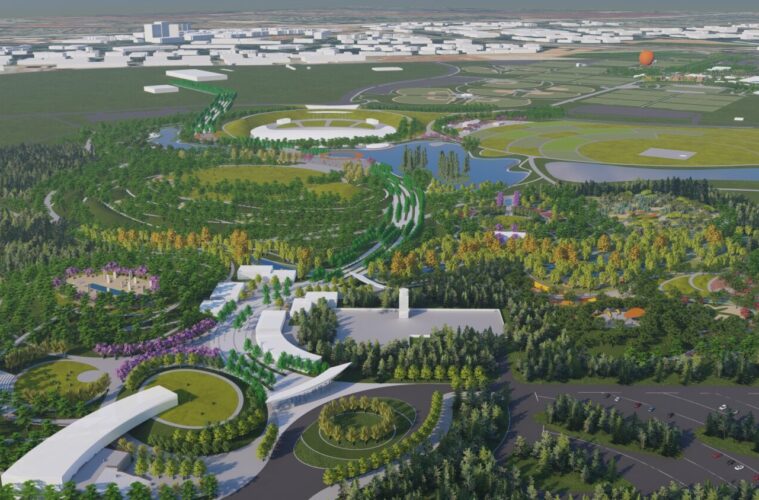From autonomous lawn mowers, multiple acres of self-filtering wetlands, and solar panel-lined parking lots and rooftops, head architects of Irvine’s $1 billion Great Park Framework Plan say once completed, the site has the potential to become a regional power source.
Sean O’Malley, Managing Principal of SWA Architects, the project’s lead design firm, recently likened the park’s state-of-the-art design to a “suburban power plant” explaining that by focusing on the aspect of carbon reduction, the park’s features will not only have the capabilities to offset carbon, but produce surplus energy.
“Energy — this is where we can make the greatest end roads in sustainability,” he said. “We think we can make more power than we use here at the park. So, this park could essentially become a power plant for the region.”
On Tuesday, Aug. 8, O’Malley presented plans for sustainability within the Great Park to its Board of Directors. In his presentation, O’Malley expressed optimism regarding a five pronged approach to sustainability – specifically carbon reduction — from the sourcing of low carbon building materials, the planting of native vegetation, the collection of stormwater and even considerations for advanced anaerobic digestion systems that would treat waste on site and reduce landfill capacity.
“At the park’s foundation are the materials themselves,” he said. “We need to be very careful how we choose materials to make sure we are doing our part in terms of sustainability. In this case sustainability means carbon reduction, both in terms of how the material is made, how it’s shipped — and, like the forest, how it can absorb the carbon on site,” O’Malley said.
While still in the early stages of construction, O’Malley explained that with carbon reduction as a core goal, the Great Park’s sustainable features will include the complete reuse of concrete from the former Marine Corps Air Station El Toro runway, and enough solar technology to produce more than 38 million kilowatt hours of power annually.
O’Malley added that the project’s proposed 38 million kilowatt hours of power is equal to approximately 167,000 trees.
Aside from the inclusion of solar, and native, carbon-offsetting vegetation, the SWA design will also rely considerably on recycling water and stormwater collection.
At the heart of the 1,300 acre park, a 22-acre lake and wetland region will become an additional source for rainwater collection. The city also plans to use the lake’s recycled water for irrigation.
The project will feature naturally filtering terraced wetlands surrounding the lake, which O’Malley said will serve as a permanent educational aspect for the public.
“This lake will be a mix of both recycled water and stormwater,” he said. “Another critical element is the wetlands – you’re rising up in grade as you get closer to the botanical gardens to the north. That gives us an opportunity to have these stepped wetlands that acts as this natural filtration system.”
O’Malley added that lake water will be pumped to the top wetland terrace, flowing downward from wetland to wetland via engineered waterfalls. The public will be able to watch this natural filter working in “real time,” he said.
Leaders in Irvine are already anticipating the lake becoming a core recreational feature of the park, with the potential to offer fishing and boating in various regions.
Irvine City Manager Oliver Chi explained that the city is currently working to determine what is possible in terms of marine recreation.
“In terms of the fish and wildlife, there will be that particular feature we need to work through how that will work in terms of stocking the lake and access to fishing. Once it is stocked, there’s the natural reproductive cycle of fish living in and growing in this marine environment,” Chi explained. “We spent a tremendous amount of time thinking about how every 120 to 250 feet there’s gonna be a different activity base along the edges of the lake, so there will be platforms that extend into the lake. There will be wetland interactive areas and we’re also looking at boating activities on the lake, the exact type and use of what kind of boats that we have is getting worked through.”
Irvine City Council Member Dr. Kathleen Treseder questioned the reliability of storm water collection, considering that California is undoubtedly familiar with the effects of drought.
“Do we have a plan in place for what we might do if we have a drought or keep the water at the level we are planning for?” Treseder asked.
Chi explained that the city is working with the Irvine Ranch Water District to ensure the project is making the best use of its water resources.
“The good news for Irvine, we have one of the most advanced recycled water programs anywhere in the country. In fact, we generate so much recycled water that IRWD is now undertaking the siphon reservoir expansion project,” Chi explained. “In order to store more of that water, given that we are looking at drawing on a reusable source at this point, all modeling indicates we should be in really good shape even in the event of a drought given that we’re not pulling from the local groundwater source.”
Advertising disclosure: We may receive compensation for some of the links in our stories. Thank you for supporting Irvine Weekly and our advertisers.

